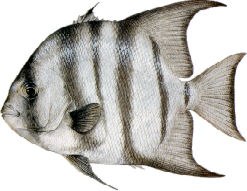Fins
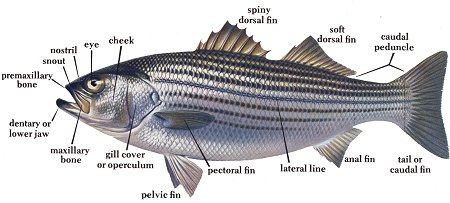
Fins come in a bewildering assortment of designs. Options include long, short, vented, solid, soft, hard, open-heel, full-foot, and a wide range of specious do-dads, most of which solve problems that I cannot confirm even exist. One manufacturer has even come out with fins that are left and right, something that I think must be truly bothersome while gearing up.
The fact is, most fin designs simply miss the mark for New Jersey divers. What is needed here is a solid, tough fin with a generous foot pocket that will hold not just your foot, but also whatever bulky thing your foot is in. This will be at least a 6mm booty, if not a drysuit boot with perhaps several pairs of socks underneath. Simple solid buckles with quick releases are essential. You will be amazed at how strongly your fins may stick onto your feet at the end of a dive. Small vents in the toe of the foot pocket help here, to break the vacuum.
Most fin reviews are based on highly scientific and totally irrelevant testing methods. A 5-10% difference in some mostly imaginary "efficiency" number simply does make any difference in the water. And since split fins came out, you can no longer believe the fin comparison tests in the magazines at all. These tests, designed and carried out by tropical "reef-kickers", have absolutely no relevance to cold-water diving.
Except for really cheap junk models and ( not at all cheap ) split fins, most fins will propel you through the water adequately. What is far more important is will it propel you comfortably. A well-designed fin should not even register in your consciousness while you dive; a poorly designed fin will give you cramps in your calves and feet, crushed toes, aching knees and ankles, and even shin splints, not to mention exhaustion. Here are a few of the better models:
Mares Plana Avanti Quattro
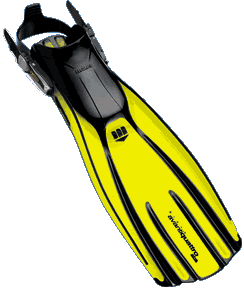
This popular and attractively designed fin consistently wins ( or used to ) in performance reviews. It has pleasant swimming characteristics, and is capable of a good turn of speed, with a snap at the end of a kick that takes a little getting used to, owing to the flexible channels in the blade. Those same delicate channels also greatly reduce this fin's durability in rough-and-tumble local diving - they split apart after a couple of seasons.
Likewise for Mares' Rube-Goldberg strap buckles, which simply do not hold up, and quickly acquire a very disconcerting way of releasing themselves. Mares' solution - make it even more complicated, now with little red lock buttons, that still don't work. Most people end up duct-taping the buckle permanently shut. What's the point of having a buckle like that?
The foot pocket is wide and flat, tapered, and very comfortable, but not particularly suited to a drysuit boot. In other words, this is probably the perfect tropical diving fin, but I wouldn't get a pair for use around here.
ScubaPro Jet / Aqualung Rocket / IDI Turtle
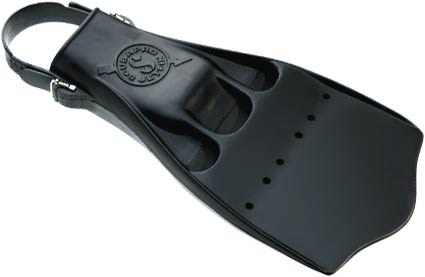
These are massive stumpy rubber fins with wide vented blades. They have generous foot pockets suitable for thick booties or drysuits. These fins are comfortable and swim quite well, solid and stable. Their apparent shortness makes them very handy in close quarters - cave divers seem to prefer them - although in truth the blades are only a couple of inches shorter than any other kind of fin. They are negatively buoyant and are practically bulletproof in construction. "Jets" are one of the very first scuba fins ever designed, and the same basic design is used by several manufacturers. Just goes to show that newer is not necessarily better. Price is fairly reasonable. Stories of thirty-year-old Jet fins are not uncommon. The foot pockets are not vented, but that is easily remedied with a drill.
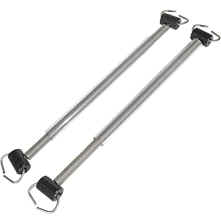
The inexpensive Aqualung Rocket, with its modern quick-release buckles, would appear to be the best value. However, Aqualung's claim of "one size fits all" is not true - the foot pocket is barely a medium, and unless you have very small feet, you are not going to be able to use this fin with a drysuit.
A better bet is the ScubaPro, in extra-large. The stock straps can be replaced with stainless-steel spring straps ( right ) if you wish. Alternatively, the Jet strap mounts are identical to the Twin Jet strap mounts, so you could easily install replacement quick-release buckles from that fin. The stock fixed fin straps are really no problem to use either and are quite comfortable once you find the notch that fits you.
IDI Turtles have the most enormous foot pocket I have ever seen and may be your only choice if you are unfortunate enough to have DUI "RockBoots" on your drysuit. Conversely, anything else might not fill it sufficiently! All of these rubber fins smell terrible when new.
Aqualung ( US Divers ) Blades
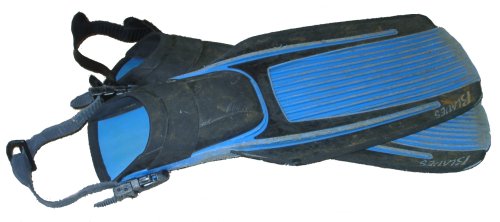
These big sturdy fins are long and clumsy out of the water, but powerful and strong in the water. Blades are slightly negative in buoyancy ( they sink, ) which doesn't hurt when wearing a thick buoyant exposure suit, and they have standard easily-replaced quick-release straps. In past performance tests, these fins usually vied for top honors with the Mares above. These rather flat and unadorned paddles are also perfect for all sorts of alternative kicks and swimming styles. Compared to many of the other fins on this page, Blades are virtually indestructible. They are also surprisingly inexpensive.
The rectangular profile of the Blades' generous foot pocket will fit almost anything you are wearing, although with lighter footwear your toes tend to get uncomfortably scrunched into the front of the pocket. In large size, this fin should fit any drysuit boot, except (again) for the idiotic DUI "RockBoot".
Recently, Aqualung replaced their classic Blades with Blades II, a sleeker, more modern-looking model that is basically similar. Blades II come with "hands-free" release buckles that look rather scary to me, but you can always replace them with trusty old-fashioned quick-release buckles and straps for a few dollars. I love my "classic" Blades and will run them until they die, which may never happen. Although they are now scuffed, scratched, and ugly, they are as solid and effective as the day I got them in 1995.
Alternative Designs
All three of the classic paddle-type fins above will translate every level of effort into thrust, right up to the point where you cannot put out any more. This is absolutely necessary in current situations or when heavily loaded with gear and drysuit. They also excel at alternative kicks ( I spend most of my time in the water "frogging", and only scissor kick when I'm in a hurry. ) their drawback is that the level of effort required may be too much for weak swimmers. Lately, a number of alternative fin designs have emerged, with different swimming characteristics:
Split Fins / Propeller Fins
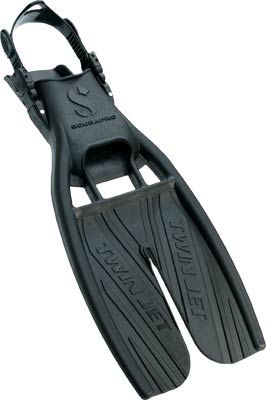
One new development in fins is the "propeller-fin" design, with a slit up the center of the blade. This is supposed to increase the efficiency of the fin, and after trying out a few types, I'd have to say that it works, albeit in a limited way. Compared with regular fins, split fins feel like you have nothing on your feet at all, but a quick sort of flutter kick will move you with less effort than you would believe. This could be a godsend for people with weak legs or who are prone to leg cramps.
The downside of these fins is that they are only good for scissor-kicking forward propulsion at moderate speeds. They are no good for frog-kicking, propellering, sculling, backpedaling, braking, hovering, or any of the other techniques that are so useful when you are trying to actually accomplish something. They are also no good for fighting a current, or pushing a heavy load of gear or a drysuit, as they are simply not capable of generating as much propulsive force as a good set of paddle fins. Strong swimmers especially may become frustrated with these fins, as they are unable to translate extra effort into thrust. You will never go fast in a pair of these.
Once on a photographic mission with a borrowed pair of split fins, I found that I was unable to back up or even hold station in almost-still water. Their uselessness for anything but forward swimming became very frustrating after a short time. Because of these poor handling characteristics, and a hefty premium in price, I doubt that these fins are ever going to replace good old paddle-fins. My personal opinion is that the loss of speed, maneuverability, and control is not worth the gain in swimming efficiency, even in the tropics. Also, all the current models I have seen are rather delicate for local use - the thin webbing in the blade tears through much too easily, especially under hard northern use. ScubaPro model shown above, probably the most suited of all split-fin designs for local diving, but I am still not recommending it. Almost every company has at least one model - they are quite all the rage right now, and quite overpriced. A dive shop by me stocks nothing but useless split fins at $150 / pair - a nice profit center in itself.
Force Fins
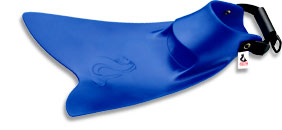
A completely different fin design comes from Force Fins. Everything said above about split fins applies to Force Fins - they handle almost identically. I tried a pair once for surface swimming ( not diving ) in a pool, and they were very comfortable. Force fins are ludicrously overpriced.
The question of whether or not a drysuit boot will fit into either a split fin or a Force fin is moot - you should not use either of these fin types with a drysuit. They simply cannot provide the necessary thrust to propel a northeast wreck diver in all reasonable situations.
Mares Volo and other models
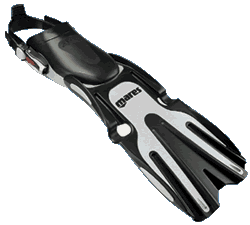
This is an interesting design that strikes a balance in performance and handling qualities between old-fashioned paddle fins and the new split fins. Volos work by having a very stiff blade that is attached to the foot pocket by an extraordinarily floppy joint. Small armatures on each side of the joint limit the amount of flex. As with split fins, there is a definite although lesser reduction in effort for forward swimming.
A short flutter kick seems to work best with these fins. Long powerful strokes are just wasted, as Volos top out low, although not as low as split fins. Unlike split fins, however, Volos are also reasonably capable of executing alternative kicks, and frogging is no problem at all. Volos suffer from the same overdesigned buckles and delicate construction as the Quattros above, and share a virtually identical foot pocket. Unfortunately, these fins fail the long-term durability test - when the joints break, you can throw them away.
Were it not for the over-hyped "propeller fins" that came out at the same time, these odd-looking fins might have made a big splash in the market. ( No pun intended. ) Mares' subsidiary Dacor sells identical models. User-replaceable batteries ( just kidding. )
Recommendations
Your choice of fins is very important. My personal recommendations are:
- If you prefer a long fin - Aqualung Blades
- If you prefer a short fin - ScubaPro Jets
- If you are a weak swimmer or have leg problems - Mares Volos or equivalent Dacor.
- Avoid Force Fins and split fins by any maker - they are simply not suited to local diving.
When buying fins, go to a dive shop and try them on over whatever footwear you expect to be using. If you haven't settled on your exposure suit yet, you might want to hold off on the purchase of fins until you do. Many people actually get two sets of fins in two different sizes, one for warm water and one for cold, but with a little planning, this is not necessary. My size 11 drysuit boots fit nicely into large AquaLung Blades and extra-large ScubaPro Jets and Twin Jets, but not Aqualung Rockets.
You may have noticed that these are all open-heel fins. What about full-foot fins? Full-foot fins are strictly for easy snorkeling and pool use - not scuba diving. A bare foot inside a full-foot fin can quickly become painfully blistered and even infected if the fit is not perfect. It can also get cold, and bare wet feet slice easily on rocks and shells when you take the fins off. A nice thick neoprene bootie inside an open-heel fin is much more comfortable, both in the water and out.
Don't economize with your fins, a little extra spent here will go a long way in making your diving more enjoyable. Cheap fins suck, what else can I say? I have had some rentals that made forward propulsion seem like wishful thinking. Body surfing fins and snorkeling fins are too small and weak to propel a scuba diver with all the extra drag from suit and equipment, and should not be used for diving. Full foot fins are strictly for bare-diving in the tropics, and even there, they are likely to be uncomfortable. And the cheap fins you find at Sports Authority and the like are not even worth mentioning.
DIR
The ScubaPro Jet type is the recommended DIR fin. A good choice. Split fins are verboten.

